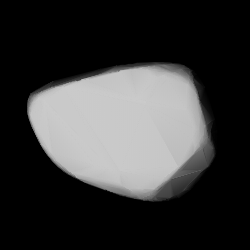 Shape model of Glarona from its lightcurve | |
| Discovery [1] | |
|---|---|
| Discovered by | P. Wild |
| Discovery site | Zimmerwald Obs. |
| Discovery date | 19 September 1965 |
| Designations | |
| (1687) Glarona | |
| Pronunciation | /ɡləˈroʊnə/ |
Named after | Glarus (Swiss canton) [2] |
| 1965 SC ·1926 UA 1931 RB1 ·1942 PD 1945 EA ·1948 QN 1948 RD1 ·1954 TB 1954 UB2 ·1959 PG 1960 XD ·1965 UX A909 UA ·A915 XC | |
| main-belt · Themis [3] | |
| Orbital characteristics [1] | |
| Epoch 4 September 2017 (JD 2458000.5) | |
| Uncertainty parameter 0 | |
| Observation arc | 107.45 yr (39,245 days) |
| Aphelion | 3.7148 AU |
| Perihelion | 2.6004 AU |
| 3.1576 AU | |
| Eccentricity | 0.1765 |
| 5.61 yr (2,049 days) | |
| 62.841° | |
| 0° 10m 32.52s / day | |
| Inclination | 2.6367° |
| 93.570° | |
| 316.57° | |
| Physical characteristics | |
| Dimensions | 31.52±0.50 km [4] 33.93±4.9 km (IRAS:6) [5] 36.75±0.93 km [6] 37.850±0.194 [7] 42.007±0.515 km [8] |
| 6.3 h [a] 6.49595±0.00001 h [9] | |
| 0.0795±0.0130 [8] 0.107±0.006 [6] 0.1219±0.044(IRAS:6) [5] 0.141±0.021 [4] [7] | |
| S [3] B–V = 0.670 [1] U–B = 0.380 [1] | |
| 10.25 [1] [3] [4] [5] [6] [8] ·10.51±0.28 [10] | |
1687 Glarona (prov. designation: 1965 SC) is a stony Themis asteroid approximately 34 kilometers in diameter from the outer region of the asteroid belt. It was discovered by Swiss astronomer Paul Wild at Zimmerwald Observatory near Bern, Switzerland, on 19 September 1965. [11] It was later named after the Swiss Canton of Glarus. [2]